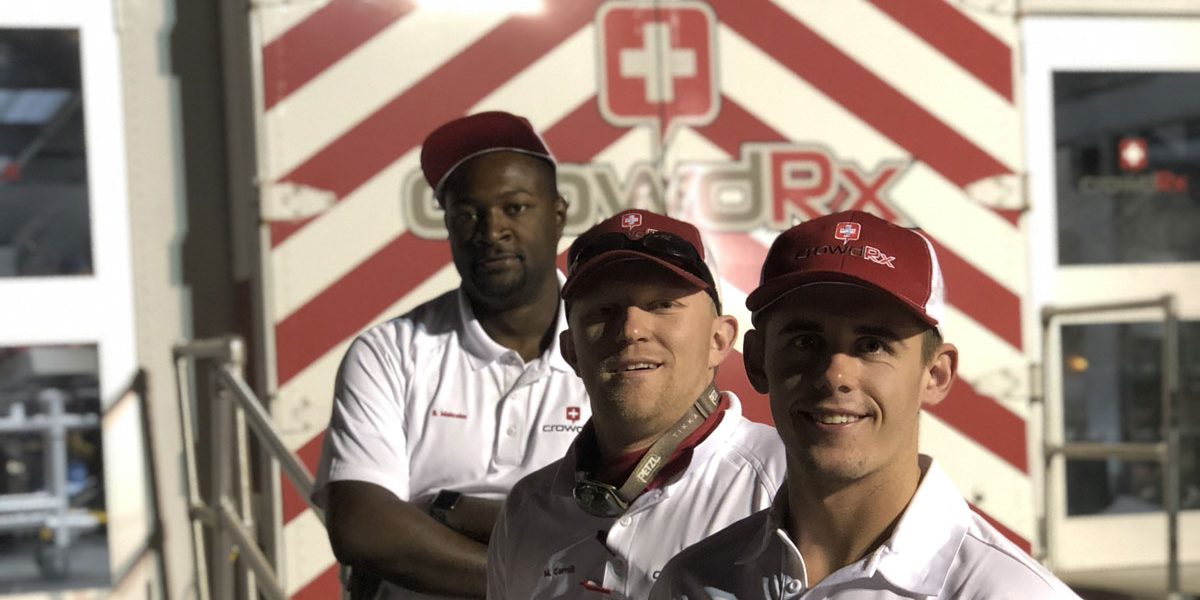At big events they can help avert needs for transport and burdening local hospitals
Nearly every city has its own rendition of a marathon, triathlon, extreme obstacle course or swim competition. It is prudent to treat these events, based on their anticipated size, number of participants, and viewing capacity, as predetermined MCIs, each requiring its own disaster plan and risk-mitigation procedures.
Not every mass gathering will becomean actual MCI. Fortunately, at fixed venues that host professional sports teams and collegiate sporting events, the patient presentation rate is rela- tively predictable and usually low com- pared to nonfixed venues where events like music festivals typically take place. While there is always a concern that a mass gathering will become an MCI andproper disaster preparedness principlesshould be employed at every one, it is thankfully rare at fixed venues hosting sporting events.

For EMS these events may require enhanced resources and more inten- sive preparations. Preventive measures may include multidisciplinary and inter- agency briefings, increased numbers of medical staff, and potentially a mobile trailer capable of providing emergencycare. The mobile emergency room trailercan have unique benefits at an MCI or mass gathering.
Controlled Environment
We frequently use the term controlled envi- ronment in EMS and emergency medicine. That patient with epiglottitis needs to be intubated in a controlled environment, so they should be taken to the OR. To performprocedural sedation to reduce the dislocated shoulder, we need a controlled environment.Essentially a controlled environment is aclean, relatively sterile workspace where youhave the room, maneuverability, and equip- ment to handle the worst-case scenario.
If you anticipate a range of patient pre-sentations from asthma to contusions, lacerations, and dislocated extremities, there is a medical advantage to having a controlled environment on site. It pro-vides room to treat all these patients in a humane environment, with each afforded the dignity, privacy, and appropriate care they deserve.
The real mortality benefit arises when you begin treating the critically ill, whichis not infrequent at large mass gather-ings. Life threats can include hyponatre-mia leading to seizures, hyperthermia resulting in multiorgan failure, severe asthma exacerbation requiring ventila- tory support, excited delirium owing to drug-induced toxicity, cardiac arrhyth- mias, and, if not interrupted promptly, cardiac arrest.

A mobile ER trailer allows multiple providers to access a patient in extremis. An EMS provider can obtain intravenousaccess in the upper extremities while another places the patient on a cardiacmonitor and obtains vital signs, while yet another is at the head, managing the air-way and comforting the patient.
The mobile trailer typically features well-organized supply cabinets offering ready access to supplies. Additionally, they typically have proper licensing credentials to run point-of-care serum andurine analyses. Knowing the serum pH andpartial pressure of carbon dioxide will be useful in determining the criticality of the patient and responsiveness to therapy.
Having cordoned-off private areas toexamine patients and obtain rectal tem- peratures will be important to determinewho has mild hyperthermia and who is severely hyperthermic, requiring a dunk in an ice-cold bath. In short, mobile ERtrailers provide a dignified, humane envi-ronment to treat every patient, but their biggest impact is seen with critically ill patients at an MCI.

Mobile emergency room trailers shouldbe completely self-sustaining for the first 72 hours and equipped and staffed to manage minor to severe emergency medical conditions. Generally they can be operational quickly after arriving on site and can accommodate expandabletents to significantly enhance their surgecapacity. When infrastructure is dam- aged or capacity diminished, the needfor surge relief is immediate and may lastfor weeks.
Logistical Advantages
There are other positive aspects to staging medical crews at a mobile ER. Using trailers helps avoid overburdening other local healthcare resources not dedicated to the mass gathering. EMS (as well as police and fire), while having to deal with extra traffic and road closures, will have its same resources to respond and hopefully not have to divert units.

The host community does not have to worry that its local hospitalwill be overrun and struggle to provide care. Some communities have experienced problems with local ERs that were ill-equipped to handle the excessive patients they saw from a mass gathering.Mobile ER trailers can dramatically cut down on the number of those transported to hospitals.
Finally, mobile ER trailers give medical staff a place to congre- gate and escape from the elements and enjoy an opportunity to recharge. Whether they need to warm up, cool down, hydrate, or change clothes, on-scene medical providers are given a place to do it with dignity and respect, thus keeping them ready to handle any scenario that may arise.
ABOUT THE AUTHORS
Matt S. Friedman, MD, FACEP, DABEMS, is associate medical director of prehospital care and director of the EMS clerkship at Maimonides Medical Center, Brooklyn, N.Y., and national medical director of CrowdRx Inc., New York, N.Y.
Connor B. Fitzpatrick, AEMT, is an AEMT instructor, ALS supervisor, volunteer pilot for Airlift Services, and Chief Operating Officer at CrowdRx Inc.


